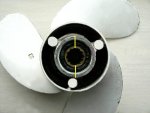Have a new 11 ft Saturn SD330 inflatable, and used, ~2000 Nissan/Tohatsu 8hp 2-stroke, that we took on the water for the first time. Have an issue I'm hoping someone can help us with.
Bear with my terminology as I have almost zero experience with outboards.
For some reason the prop seems to cavitate (catch air?!) when we try to get up on plane, like a clutch slipping on a car. If I give it full throttle the prop will cavitate, rev very high, than catch water for a moment, drop RPM's, then air again.
I've tried all 6-7 engine "trim" angle positions with similar results. Fwiw, the "top" part of the prop's outer turning radius is about 3" below the transom so I don't believe there's any issue with the Nissan's shaft length. The Saturn rear transom is about 14-15" deep. I believe the Nissan is a short shaft motor.
If we take the time to adjust the engine trim angle just so AND my wife positions herself perfectly fore-aft we can prevent the prop from cavitating and can apply full throttle; however, the bow is high and it won't quite get on a plane. Plus, the boat feels like it's dragging an anchor. Clearly something is wrong.
It cavitates riding solo in all engine trim positions. I only weigh approx. 140 lbs. My wife only weighs 110 lbs.
Just to be clear, the issue is not so much not getting on a plane, but the fact the prop appears to cavitate (and over rev) under med/high throttle conditions.
Do I have a bad prop? Current prop doesn't appear bent. There's some light nicks and wear on the leading edge, but that's about it.
Thanks in advance for any help!
Bear with my terminology as I have almost zero experience with outboards.
For some reason the prop seems to cavitate (catch air?!) when we try to get up on plane, like a clutch slipping on a car. If I give it full throttle the prop will cavitate, rev very high, than catch water for a moment, drop RPM's, then air again.
I've tried all 6-7 engine "trim" angle positions with similar results. Fwiw, the "top" part of the prop's outer turning radius is about 3" below the transom so I don't believe there's any issue with the Nissan's shaft length. The Saturn rear transom is about 14-15" deep. I believe the Nissan is a short shaft motor.
If we take the time to adjust the engine trim angle just so AND my wife positions herself perfectly fore-aft we can prevent the prop from cavitating and can apply full throttle; however, the bow is high and it won't quite get on a plane. Plus, the boat feels like it's dragging an anchor. Clearly something is wrong.
It cavitates riding solo in all engine trim positions. I only weigh approx. 140 lbs. My wife only weighs 110 lbs.
Just to be clear, the issue is not so much not getting on a plane, but the fact the prop appears to cavitate (and over rev) under med/high throttle conditions.
Do I have a bad prop? Current prop doesn't appear bent. There's some light nicks and wear on the leading edge, but that's about it.
Thanks in advance for any help!




















